6. NUCLEIC ACIDS AND PROTEIN SYNTHESIS
1/86
There's no tags or description
Looks like no tags are added yet.
Name | Mastery | Learn | Test | Matching | Spaced |
|---|
No study sessions yet.
87 Terms
What are nucleotides, and why are they important?
Nucleotides are the monomers that form nucleic acids (DNA and RNA). These macromolecules store genetic information and are involved in protein synthesis.
What are the three components of a nucleotide?
Nitrogenous Base (e.g., adenine, thymine, cytosine, guanine, uracil).
Pentose Sugar (DNA: deoxyribose; RNA: ribose).
Phosphate Group.
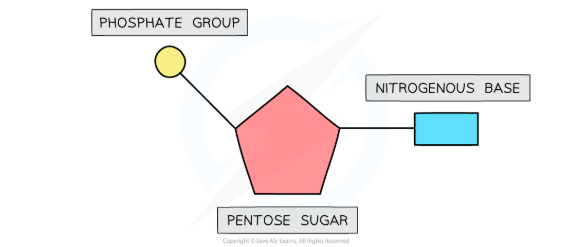
How do DNA and RNA nucleotides differ?
Pentose Sugar: DNA has deoxyribose; RNA has ribose.
Nitrogenous Bases: DNA includes thymine, while RNA includes uracil.
Strands: DNA is double-stranded (double helix), RNA is single-stranded.
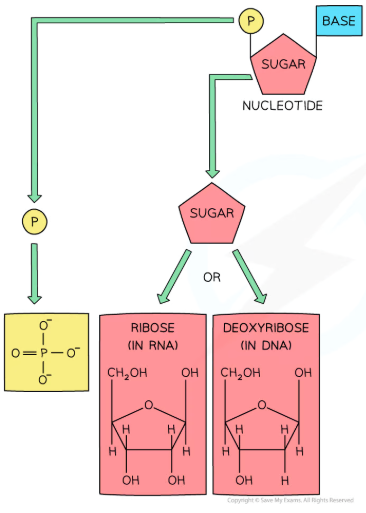
What is ATP, and how is it related to nucleotides?
ATP (adenosine triphosphate) is an energy-carrying molecule that powers cellular processes. It is a phosphorylated nucleotide consisting of:
Adenosine (a nucleoside: adenine + ribose).
Three phosphate groups. ATP can lose phosphate groups to form ADP (adenosine diphosphate) or AMP (adenosine monophosphate).
Why is ATP important for cells?
ATP provides energy for biological processes such as active transport, muscle contraction, and biochemical reactions.
What are the differences between purines and pyrimidines?
Purines: Double-ring structure (adenine and guanine).
Pyrimidines: Single-ring structure (cytosine, thymine, uracil).
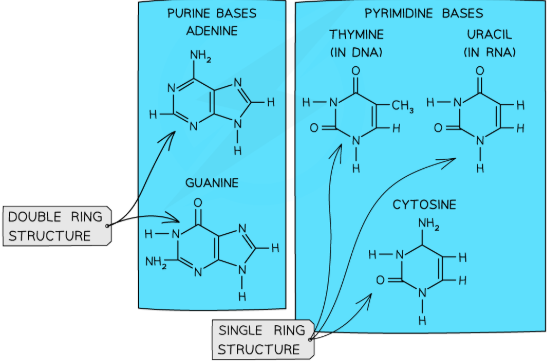
Adenine vs. Adenosine
What is the difference between adenine and adenosine? A:
Adenine: A nitrogenous base.
Adenosine: A nucleoside (adenine attached to a pentose sugar).
How are DNA and RNA described as polymers?
DNA and RNA are polynucleotides, meaning they are long chains of nucleotides joined by phosphodiester bonds.
What should you remember for exams regarding nucleotide structure?
Focus on components (base, sugar, phosphate group).
Remember the difference between purines and pyrimidines.
Understand ATP structure and function without memorizing structural formulae.
What is DNA, and what is it made of?
DNA (Deoxyribonucleic acid) is a polynucleotide made of many nucleotides linked together in a long chain. It stores genetic information.
What are the three components of a DNA nucleotide?
Nitrogenous Base (Adenine, Thymine, Cytosine, Guanine).
Deoxyribose Sugar (Pentose sugar).
Phosphate Group.
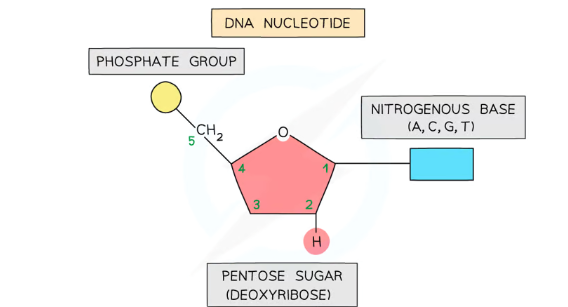
What is the structure of DNA strands and how are the two strands held together.
DNA consists of two polynucleotide strands running in opposite directions, known as antiparallel strands:
5’ to 3’ Strand: Phosphate group linked to the 5-carbon.
3’ to 5’ Strand: Phosphate group linked to the 3-carbon.
DNA strands are held together by hydrogen bonds between complementary base pairs.
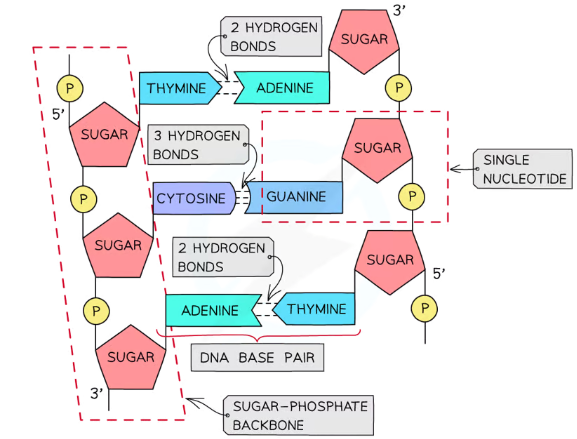
What forms the sugar-phosphate backbone of DNA and what is the relevance of these bonds?
Alternating deoxyribose sugars and phosphate groups bonded by phosphodiester bonds, which are covalent bonds. These covalent bonds link nucleotides together in the sugar-phosphate backbone, ensuring the stability of DNA strands.
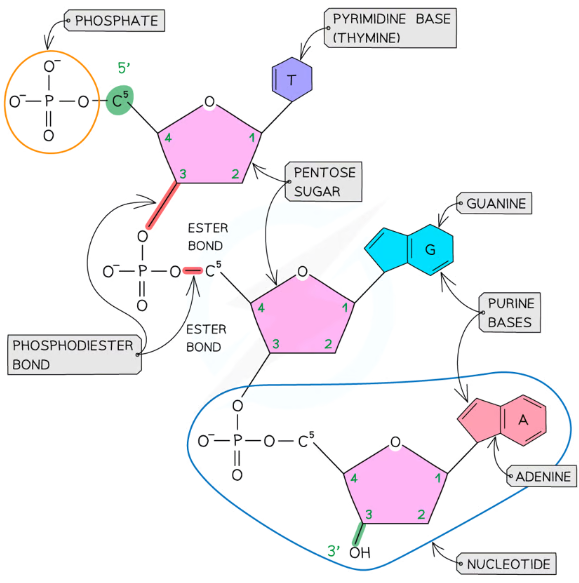
What is complementary base pairing in DNA?
Nitrogenous bases pair with each other:
Adenine (A) pairs with Thymine (T) via 2 hydrogen bonds.
Guanine (G) pairs with Cytosine (C) via 3 hydrogen bonds. This pairing ensures accuracy in DNA replication.
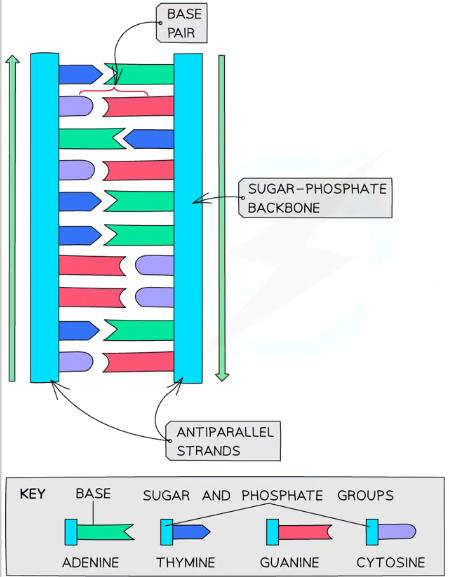
What is the double helix structure of DNA?
DNA forms a three-dimensional double helix where the strands twist around each other. The nitrogenous bases project inward.
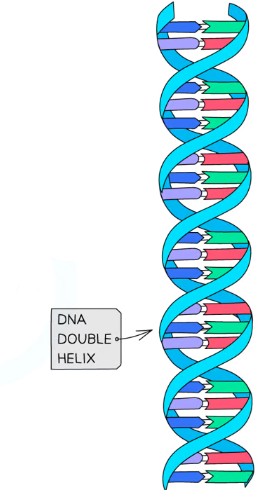
What key points should you know for exams on DNA structure?
Memorize components: sugar-phosphate backbone, base pairs, phosphodiester bonds, hydrogen bonds.
Understand antiparallel strands and complementary base pairing.
Know the number of hydrogen bonds between base pairs.
What is semi-conservative DNA replication, and when does it occur?
DNA replication occurs during the S phase of interphase in the cell cycle. Semi-conservative replication produces two DNA molecules, each containing one original strand and one newly synthesized strand.
What does "semi-conservative replication" mean?
It means half of the original DNA molecule is conserved in each of the two new DNA molecules.
What are the main steps of semi-conservative replication?
Unzipping the DNA: Hydrogen bonds between base pairs are broken, separating the two polynucleotide strands.
Template Strands: Each single strand acts as a template for a new complementary strand.
New DNA Formation: New strands are synthesized using free activated nucleotides.
What is the role of DNA polymerase in DNA replication?
Aligns complementary nucleotides to the template strands.
Catalyzes condensation reactions between adjacent nucleotides, forming the sugar-phosphate backbone.
Cleaves two extra phosphates from nucleoside triphosphates, releasing energy to form phosphodiester bonds.
What is the role of DNA ligase in DNA replication?
DNA ligase joins Okazaki fragments on the lagging strand, forming a continuous DNA strand.
How are the leading and lagging strands synthesized?
Leading Strand: Synthesized continuously in the 5’ to 3’ direction toward the replication fork.
Lagging Strand: Synthesized in short segments (Okazaki fragments) as DNA polymerase moves away from the replication fork.
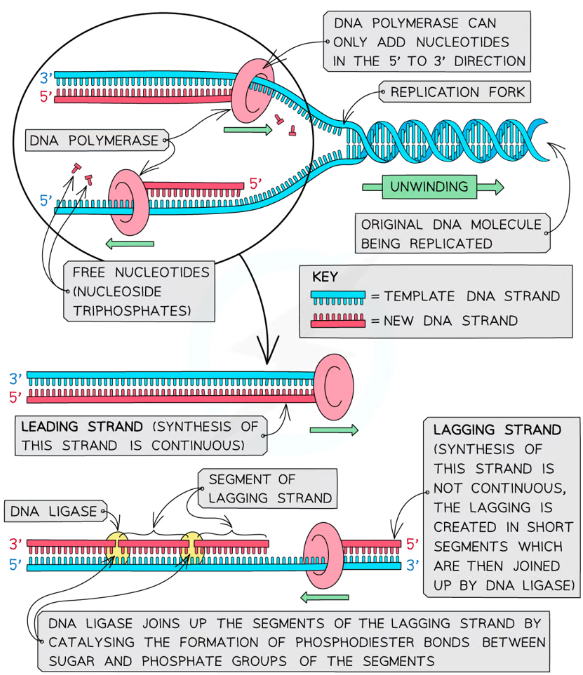
Why does DNA synthesis occur only in the 5’ to 3’ direction?
DNA polymerase can only attach new nucleotides to the 3’ end of the growing strand, requiring synthesis in the 5’ to 3’ direction.
What are activated nucleotides, and why are they important?
Activated nucleotides are nucleosides with three phosphate groups. They provide the energy needed for DNA replication when the extra phosphates are cleaved.
What is meant by antiparallel strands in DNA?
DNA's two strands run in opposite directions:
One strand is 5’ to 3’, and the other is 3’ to 5’. This impacts replication of the leading and lagging strands.
What are Okazaki fragments, and how are they joined?
Okazaki fragments are short DNA segments on the lagging strand, joined by DNA ligase to form a continuous strand.
What evidence supports semi-conservative replication?
Meselson and Stahl's experiment (1958) used nitrogen isotopes 15N and 14N with E. coli bacteria, demonstrating how DNA density changed over generations. They used E. coli (a bacteria) and two nitrogen isotopes, a heavy form 15N and the ‘normal’ form 14N, to demonstrate how the density of DNA changes over generations as the 15N isotope was replaced with the 14N isotope
What should you focus on for exam questions about DNA replication?
Roles of DNA polymerase and DNA ligase.
Differences between leading and lagging strands.
Understand terms like antiparallel strands and Okazaki fragments.
What is RNA, and how is it similar to DNA?
RNA (ribonucleic acid) is a polynucleotide, like DNA, consisting of many nucleotides joined in a long chain.
What are the components of an RNA nucleotide?
Nitrogenous Bases: Adenine (A), Cytosine (C), Guanine (G), Uracil (U) (No thymine in RNA).
Pentose Sugar: Ribose (instead of deoxyribose in DNA).
Phosphate Group.

What are the key differences between RNA and DNA nucleotides?
RNA contains ribose, whereas DNA contains deoxyribose.
RNA contains uracil (U), whereas DNA contains thymine (T).
What distinguishes RNA from DNA in terms of structure?
RNA is single-stranded, unlike DNA, which is double-stranded.
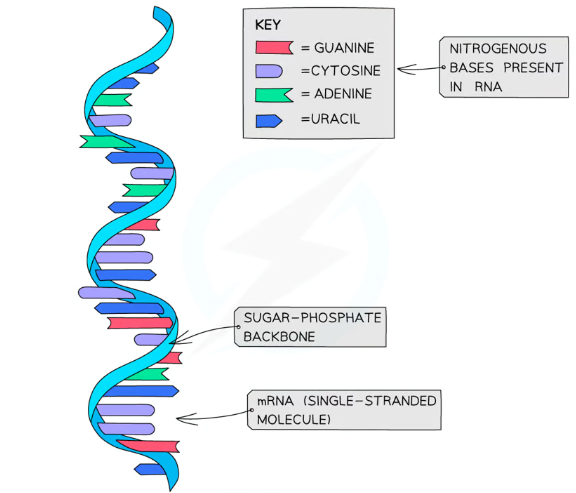
What forms the sugar-phosphate backbone of RNA?
Alternating ribose sugars and phosphate groups linked by phosphodiester bonds.
What is the role of phosphodiester bonds in RNA?
They link the 5-carbon of one ribose sugar to the phosphate group, which is further linked to the 3-carbon of the next ribose sugar.
How are the nitrogenous bases positioned in RNA?
Bases project out sideways from the sugar-phosphate backbone.
What is mRNA, and what is its role?
mRNA is a transcript copy of a gene. It carries the genetic code from DNA to the ribosome for protein synthesis.
What are the other types of RNA besides mRNA?
Transfer RNA (tRNA): Transfers amino acids during translation.
Ribosomal RNA (rRNA): Combines with proteins to form ribosomes.
What should you focus on for RNA structure in exams?
Differences between RNA and DNA: Bases (U vs. T), sugars (ribose vs. deoxyribose), strands (single vs. double).
The structure of RNA, including the sugar-phosphate backbone and nitrogenous base positioning.
What is a gene and how does it code for a polypeptide
A gene is a sequence of nucleotide bases that forms part of a DNA molecule and codes for the production of a specific polypeptide. A gene’s nucleotide sequence determines the exact sequence of amino acids in a polypeptide, which forms the primary structure of a protein.
What is the central dogma of molecular biology?
One gene codes for one mRNA molecule, which in turn codes for one polypeptide.
How are genes organized within a DNA molecule?
Each DNA molecule contains thousands of genes, each with a specific start and stop point to ensure the correct protein is produced.
What is the relationship between chromosomes and DNA?
Each chromosome contains one long DNA molecule that houses thousands of genes.
What is the importance of the nucleotide sequence in genes?
The nucleotide sequence controls the order of amino acids in a polypeptide, thus determining the structure and function of proteins.
What key points should you focus on for exams about genes and polypeptides?
Understand that a gene codes for a specific polypeptide.
Learn the relationship between nucleotide sequences and amino acid sequences.
Be familiar with the central dogma: gene → mRNA → polypeptide.
What is the genetic code?
The genetic code is the sequence of nucleotide bases within a gene that codes for a specific sequence of amino acids, forming a polypeptide.
How is the genetic code organized in DNA?
The genetic code is a triplet code, where each sequence of three bases (triplet) codes for a single amino acid.
Provide examples of DNA triplets and their corresponding amino acids.
CAG → Valine
TTC → Lysine
GAC → Leucine
CCG → Glycine
What are start and stop codons?
Start Codon: TAC (codes for methionine) indicates where translation begins.
Stop Codons: Signal the end of translation, ensuring proper protein synthesis.
Why is the genetic code described as non-overlapping?
Each base is part of only one triplet, ensuring that the DNA is read correctly and proteins are synthesized accurately.
What is meant by the degeneracy of the genetic code?
Multiple triplets can code for the same amino acid. For example:
GGA, GGG, GGC, GGT → All code for glycine. This reduces the impact of mutations.
What does it mean that the genetic code is universal?
The same triplets code for the same amino acids in almost all organisms, enabling genetic information to be transferable across species.
How many triplets exist, and why are there only 20 amino acids?
There are 64 possible triplets (4 bases^3), but only 20 amino acids are used in biological proteins. This explains the degeneracy of the code.
How is the universality of the genetic code applied in science?
It facilitates genetic engineering, where genes from one organism are transferred to another species (e.g., producing insulin in bacteria).
What key points should you focus on for exams about the genetic code?
Understand triplets, start and stop codons, and their functions.
Be familiar with examples of codons and amino acids.
Highlight the importance of degeneracy and the universal nature of the code.
What are the stages of protein synthesis?
Protein synthesis occurs in two stages:
Transcription: DNA is transcribed into mRNA in the nucleus.
Translation: mRNA is translated into an amino acid sequence in the cytoplasm.
What happens during transcription?
Transcription is the process where a complementary mRNA molecule is produced based on the DNA template strand. It occurs in the nucleus during protein synthesis.
Steps in Transcription:
Unwinding DNA:
The DNA molecule unwinds, breaking hydrogen bonds between base pairs.
This exposes the gene to be transcribed (the gene contains the code for the polypeptide).
Template Strand:
Only the template strand of DNA is used to build the mRNA molecule.
RNA Nucleotide Pairing:
Free activated RNA nucleotides pair with complementary bases on the DNA template strand:
Adenine (A) pairs with Uracil (U) in RNA (no thymine in RNA).
Thymine (T) pairs with Adenine (A).
Cytosine (C) pairs with Guanine (G), and vice versa.
Formation of mRNA:
RNA polymerase catalyzes the bonding of RNA nucleotides, forming the sugar-phosphate backbone via phosphodiester bonds.
This creates a single-stranded mRNA molecule.
Completion of Transcription:
Hydrogen bonds between the mRNA and DNA break, releasing the mRNA molecule.
The DNA strand re-forms into its double-stranded structure.
Exit from Nucleus:
The mRNA molecule exits the nucleus through pores in the nuclear envelope, traveling to the cytoplasm for translation.
What is the function of RNA polymerase in transcription?
RNA polymerase catalyzes the formation of the mRNA strand by joining RNA nucleotides together to form the sugar-phosphate backbone.
What is mRNA, and what is its role?
mRNA is a single-stranded molecule that carries the genetic code from the DNA to the ribosome for translation. It contains codons (triplets of bases).
What happens during translation?
Translation is the process where the mRNA sequence is translated into an amino acid chain (polypeptide). It occurs at the ribosome in the cytoplasm.
Steps in Translation:
Binding to Ribosome:
The mRNA molecule binds to a ribosome in the cytoplasm.
The ribosome reads mRNA codons (triplets of bases).
Role of tRNA:
Free tRNA (transfer RNA) molecules in the cytoplasm bind to specific amino acids.
Each tRNA molecule has:
A specific anticodon (triplet of unpaired bases) that pairs with a complementary codon on mRNA.
An amino acid binding site where a particular amino acid attaches.
Codon-Anticodon Pairing:
The ribosome aligns the anticodon on tRNA with the complementary codon on mRNA.
Example: AUG on mRNA pairs with UAC on tRNA.
Formation of Amino Acid Chain:
The ribosome holds two tRNA molecules at a time.
Peptide bonds form between adjacent amino acids, catalyzed by the ribosome.
The growing polypeptide chain is transferred to the tRNA in the second binding site.
Stop Codon and Completion:
A stop codon (UAA, UAG, UGA) signals the end of translation.
The polypeptide chain detaches and folds into its functional protein structure.
What are codons and anticodons?
Codons: Triplets of bases on mRNA that specify an amino acid.
Anticodons: Triplets of bases on tRNA that pair with complementary codons on mRNA.
How do ribosomes contribute to protein synthesis?
Ribosomes provide a platform for translation, where mRNA codons are matched with tRNA anticodons, and amino acids are joined to form a polypeptide chain.
What is the purpose of a stop codon in translation?
The stop codon signals the end of translation, completing the amino acid chain that forms the final polypeptide.
How is the polypeptide finalized after translation?
The amino acid chain folds into its functional protein structure.
What is the name of the DNA strand used during transcription, and what is the name of the other strand?
Template strand (or transcribed strand): The strand of DNA that is used during transcription. This strand is responsible for coding the mRNA molecule. It contains the sequence that RNA nucleotides pair with.
Non-template strand (or non-transcribed strand): The DNA strand that is not used in transcription. Its sequence matches the mRNA codons but has Thymine in place of Uracil.
What happens to the DNA molecule during transcription?
The section of the DNA molecule containing the gene coding for a particular polypeptide unwinds.
Hydrogen bonds between complementary base pairs are broken, causing the two DNA strands to unzip.
How do RNA nucleotides pair during transcription?
Free activated RNA nucleotides pair with exposed bases of the DNA molecule.
RNA nucleotides only pair with bases on the template strand.
What is the function of RNA polymerase in transcription?
RNA polymerase binds RNA nucleotides together.
It creates the sugar-phosphate backbone of the mRNA molecule, forming a stable chain ready for translation.
What happens to the mRNA molecule formed during transcription?
The mRNA molecule carries the transcribed genetic information.
It is transported out of the nucleus for translation into an amino acid chain in the ribosomes.
How are sense and anti-sense strands referred to in transcription?
The sense strand is now called the non-transcribed strand.
The anti-sense strand is now called the template strand.
Key Tip: mRNA codons have the same base sequence as the non-transcribed strand, except Uracil replaces Thymine.
What is post-transcriptional modification in eukaryotes?
It is the process by which the RNA molecule (primary transcript) formed during transcription undergoes modifications before it is translated.
The modifications include removal of introns (non-coding sequences) and joining together of exons (coding sequences) to form mature mRNA.
What are exons and introns in eukaryotic genes?
Exons: The coding sequences of DNA that will eventually be translated into amino acids. They remain in the mature mRNA.
Introns: The non-coding sequences of DNA that do not code for any amino acids and are removed during post-transcriptional modification.
What does the primary transcript contain in eukaryotes?
The primary transcript is the RNA molecule formed immediately after transcription.
It contains both exons (coding sequences) and introns (non-coding sequences).
Why are introns removed from the primary transcript?
Introns are not translated into amino acids and do not contribute to the final polypeptide.
To ensure accurate translation, introns are removed during post-transcriptional modification.
How is mature mRNA formed?
Introns are removed from the primary transcript through a process called splicing.
Exons are joined together to form a continuous strand of RNA, known as mature mRNA.
Mature mRNA is ready for translation into an amino acid chain.
What is splicing in post-transcriptional modification?
Splicing is the process of removing introns from the RNA molecule and joining exons together.
This results in the formation of mature mRNA.
It occurs in the nucleus of eukaryotic cells.
Why is post-transcriptional modification essential?
It ensures that the RNA molecule is accurate and only contains coding sequences necessary for translation.
It prevents errors during translation that could lead to faulty polypeptide chains.
How should you remember post-transcriptional modification for exams?
Remember that introns are removed, and exons are expressed.
Highlight the term splicing as a key part of the process.
Keep in mind that post-transcriptional modification prepares RNA for translation into proteins.
What is a gene mutation?
A gene mutation is a change in the sequence of base pairs in a DNA molecule.
It may result in an altered polypeptide.
Do mutations occur regularly?
Mutations occur continuously as part of natural biological processes.
How does a change in the DNA base sequence affect proteins?
The DNA base sequence determines the sequence of amino acids in a protein.
Mutations can lead to changes in the polypeptide coded for by a gene.
Why do most mutations not significantly affect polypeptides?
The genetic code is degenerate, meaning multiple codons may code for the same amino acid.
Most mutations either do not alter the polypeptide or change it slightly without affecting its function.
What is an insertion mutation, and how does it affect polypeptides?
Insertion mutation: A new nucleotide is randomly inserted into the DNA sequence.
It creates a different base triplet, causing a change in the amino acid.
The insertion also has a knock-on effect on triplets further along, causing a frameshift mutation.
Frameshift mutations can dramatically alter the polypeptide and its ability to function.
What is a deletion mutation, and how does it affect polypeptides?
Deletion mutation: A nucleotide is randomly removed from the DNA sequence.
It changes the amino acid coded for and causes a frameshift mutation, altering triplets further along.
This can significantly affect the polypeptide and its function.
What happens in substitution mutations, and what are their types?
A substitution mutation occurs when one base is swapped for another.
It only affects the amino acid of the mutated triplet and does not have a knock-on effect.
Types:
Silent mutations: No change in the amino acid sequence due to the degenerate genetic code.
Missense mutations: Alter a single amino acid in the polypeptide chain (e.g., sickle cell anemia).
Nonsense mutations: Create a premature stop codon, leading to incomplete polypeptides (e.g., cystic fibrosis).
How do mutations affect proteins?
Most mutations do not alter the protein structure or function.
Some mutations code for a significantly altered polypeptide that affects function:
If the enzyme’s active site shape changes, substrates cannot bind.
Structural proteins (e.g., collagen) may lose strength if their shape changes.
What is important to remember about silent mutations?
Silent mutations result in the same amino acid sequence, as some amino acids have multiple codons.
These often involve changes in the 2nd or 3rd base of the codon.